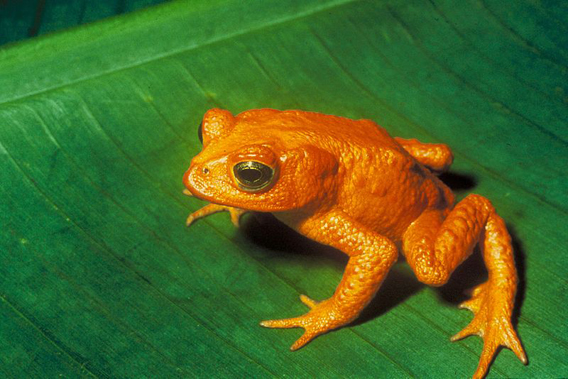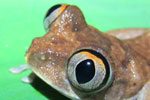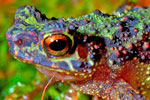
The golden toad (Bufo periglenes) is one of well-over a hundred frogs that are believed to have gone extinct over the past few decades. Photo by: US Fish and Wildlife Service.
A new initiative by the conservation group, Amphibian Ark, hopes to match lonely, vanishing frogs with a prince/princess to to save them. Dubbed FrogMatchMaker.com after online dating sites, the program is working to connect supporters and donors with amphibian conservation programs in need. Currently, amphibians are among the world’s most imperiled species with 41 percent threatened with extinction according to the IUCN Red list.
“This website currently includes 48 projects in 23 countries on three continents and can be searched by country, region, species, funding amount required, and by project type,” explains Kevin Johnson, Amphibian Ark Communications Officer, in a press release. “You can also browse new projects that have been added in the last 30 days or projects that have been added in the last 60 days. Using FrogMatchMaker.com, donors have been able to easily locate amphibian conservation projects that are a good match with their organizations’ missions, and provide appropriate support, to ensure the success of these vital programs.”
Many of the programs, which range from requests of $1,500 to over a million, are working to set up breeding and monitoring programs for endangered amphibian species. Support doesn’t have to come from just funding, some programs are in need of equipment, staff, or training.
Experts believe around 200 amphibians have gone extinct in the past few decades. Habitat loss, pollution, invasive species, overexploitation, and climate change are hurting many populations. But the last straw for many frofs has been the fungal disease, chytridiomycosis, which has burned through populations, sometimes killing off once-abundant species in pristine environments.
“For every one species of bird or mammal in trouble, there are two to three amphibian species on the brink of extinction,” says Dr. Kevin Zippel, Amphibian Ark Program Director. “The current amphibian extinction crisis is reminiscent of the disappearance of the dinosaurs, making it one of the greatest conservation challenges in the history of humanity.”
However, amphibian conservation rarely garners the same attention—or funds—as mammal or bird conservation efforts. Despite the crisis, many of the world’s threatened amphibians have received little-to-no conservation support. Focusing on these forgotten frogs, FrogMatchMaker.com hopes to change this.
It has already linked up one support with a critical program: the Denver Zoo has recently provided funding to establish a recuse population of the Lake Titicaca water frog (Telmatobius culeus). Listed as Critically Endangered, the species is imperiled by invasive trout, water pollution, and over-harvesting for food.
Related articles
Saving Ghana’s vanishing frogs

(11/02/2011) Frogs need all the help they can get. With the IUCN Red List estimating that 41 percent of amphibians are endangered, frogs are currently the world’s most imperiled animal family. Scientists estimate that around 200 amphibian species have been lost to extinction in recent decades to habitat loss, pollution, and a devastating fungal disease. Yet as the frog emergency worsens, there have been positive movements in conservation. The most recent comes from the small West African country of Ghana. Partnering with the enthusiastic US-based organization, SAVE THE FROGS!, two Ghanaian herpetologists, Gilbert Baase Adum and Caleb Ofori, have started a sister branch in their country: SAVE THE FROGS! Ghana.
Scientists find frog genes that provide immunity to extinction plague
(09/27/2011) Scientists with Cornell have discovered genetics that may provide immunity to frogs in face of the killer amphibian-disease chytridiomycosis. This plague, which is spreading to amphibian populations worldwide, is responsible for a number of frog species’ recent extinction. But now researchers report in a new study in the Proceedings of the National Academy of Sciences (PNAS) that they are one step closer to understanding why some frog populations are able to fend off the disease, while others succumb with lightning-speed. In time, the results may lead to breeding strategies in captivity that could produce immune populations.
First ever picture of long lost rainbow toad

(07/13/2011) Scientists are elated after the surprise rediscovery of a wildly-colored frog not seen for 87 years and never before photographed—until now. The Bornean rainbow toad, also known as the Sambas Stream toad (Ansonia latidisca) was rediscovered on Borneo in the Malaysian state of Sarawak by local scientists inspired by a 2010 search for the world’s missing amphibians by Conservation International (CI). Leading up to its search CI released the World’s Top 10 Most Wanted Lost Frogs (out of a hundred being searched for): the Bornean rainbow toad was listed as number 10.